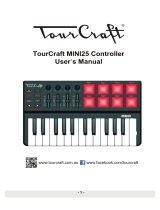
6
Connecting to a computer or MIDI devices
•
To exchange MIDI messages with your computer, connect your computer to
the USB B connector on the monologue.
•
To exchange MIDI messages with an external MIDI device, connect the de-
vice to the MIDI IN/OUT connectors on the monologue.
TIP
For details, refer to “Understanding MIDI” (p. 51)
Connecting the SYNC IN and OUT jacks
•
Use the SYNC IN and OUT jacks of the monologue when you want to syn-
chronize to the output pulses and steps from the audio output jacks of sourc-
es such as the Korg volca series or a DAW. Connect using a Sync cable.
•
The SYNC OUT jack sends a 5 V pulse of 15 ms at the beginning of each step.
TIP
Refer to “Buon 5 (GLOBAL 3)” (p. 41) of GLOBAL EDIT mode for
the seings to turn on the monologue.
Turning the monologue On and O
Before you turn the monologue On:
Installing batteries
Make sure that the monologue’s power is turned o.
1.
Open the baery cover on the monologue’s boom panel.
While pressing the latch, pull upward and remove.
2.
Insert six AA baeries, taking care to observe the cor-
rect polarity (+/− orientation).
Use alkaline or nickel-metal hydride baeries.
3.
Reaach the baery cover.
In order for the remaining baery amount to be detected and shown
correctly, you must use the parameter in GLOBAL EDIT mode to
specify the type of baeries that you’re using. By default, this seing
is set to “Alkaline.” For details, refer to “Baery Type” (p. 43).
When the baeries become depleted, “Baery Low” will appear on the dis-
play. When this occurs, it’s time to replace the baeries.
Remove old baeries immediately. Otherwise, baery leakage may oc-
cur, resulting in a malfunction. If you don’t think that you’ll be using
the un
it for a long period of time, you should remove the baeries.
1





















